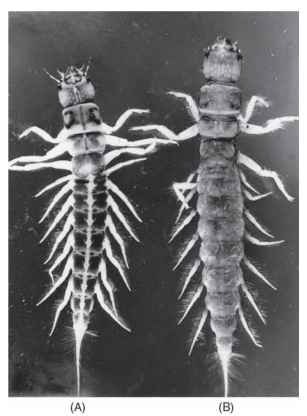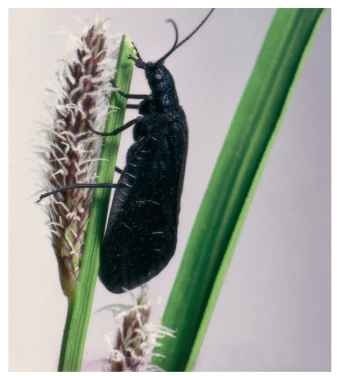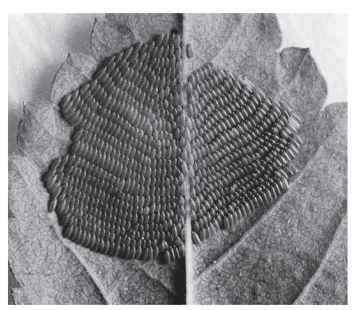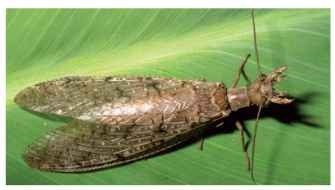The Megaloptera, which include the alderflies, dobsonflies, fishflies, and hellgrammites, are a small order of neuropterous insects with 328 described species. They are often considered to be the most primitive group of insects with complete metamorphosis. In the fossil record, Megaloptera first occur about 250 mya in the late Permian. The Megaloptera are most closely related to the Raphidioptera (snakeflies) and Neuroptera (lacewings and antlions), although the interordinal relationships between these three groups are uncertain. Among the major orders, they are most closely related to the Coleoptera (beetles). Larvae of all Megaloptera are aquatic predators. Their association with cool, well-oxygenated waters probably accounts for their greater species diversity in temperate regions than in the tropics. Although they are found throughout the world, the distributions are discontinuous, which is characteristic of a relict fauna.
DIAGNOSIS AND CLASSIFICATION
Megaloptera can be distinguished from other orders of insects by the following combination of characters: holometaboly, terrestrial adults and eggs, predaceous aquatic larvae, and exarate terrestrial pupae.
The adults are large, short-lived, and soft-bodied; the head is broad and flattened, with chewing mouthparts, large bulging compound eyes, and long many-segmented antennae; there are two pairs of similar membranous wings, held rooflike over the body, with all major veins present and many cross-veins; the five-segmented tarsi have paired apical claws; and the abdomen has 10 segments, eight pairs of spiracles, and lacks cerci.
The larvae have a well-sclerotized head, with long toothed mandibles, four- or five-segmented antennae, and six lateral stemmata (eyespots); the thorax is sclerotized dorsally, with a quadrate prono-tum, meso- and metathoracic spiracles, and elongate five-segmented legs with two tarsal claws; and the abdomen is soft, with seven or eight pairs of lateral filaments, and spiracles on segments 1-8.
The order contains two families, Sialidae and Corydalidae. Sialids, or alderflies, are slow, awkwardly flying insects that range from 10 to 15 mm in length. Their bodies are black, brown, or yellowish orange. The wings are held tentlike over the abdomen so that they bear some resemblance to caddisflies (Trichoptera). The Corydalidae are much larger, 40-75 mm in length. Many species have pale, smoky wings mottled with brown, whereas others are nearly black, with white markings. This family is divided into two distinctive subfamilies: the Corydalinae or dobsonflies (larvae are hellgrammites), and the Chauliodinae or fishflies.
FAMILY SIALIDAE
Of the eight genera in the family Sialidae (Figs. 1-3), only the widespread Holarctic genus Sialis has received much attention. The life history of S. lutaria has been studied extensively in Europe, and the larvae have been used in behavioral and physiological experiments. Sialis larvae are found in many habitats, ranging from small springs to large rivers and from ponds to large lakes. They usually occur where the substrate is soft and where dead leaves and other detritus have accumulated. Larvae may dig into the substrates to a depth of several centimeters. Sympatric species may be ecologically segregated based on habitat. For example, in Oregon S. rotunda occurs in ponds with a muddy bottom, whereas S. californica is usually found in pools or glides of streams. However, the two species can be found together in backwater reaches.
The life cycle takes 1 or 2 years depending on physical and biological conditions. The colder and less productive habitats such as trout streams and mountain lakes lengthen the period of larval life, whereas rapid development occurs in warm, productive habitats such as lowland ponds, warm lakes, and muddy rivers.
Larvae feed nonselectively on small invertebrates such as insect larvae, annelid worms, crustaceans, and mollusks. The prey is seized by the elongate mandibles and forelegs and worked into the mouth

FIGURE 1 Mature larvae of Sialis: (A) S. rotunda and (B) S. cali-fornica.

FIGURE 2 Sialis adult.

FIGURE 3 S. californica egg masses.
with the aid of labrum, maxillae, and labium. Sometimes only the softer abdominal parts of prey are eaten. Cannibalism occurs, especially in high-density situations.
During spring or early summer the final instars move to shallow areas near the shore. They then leave the water and prepare to pupate. The transformation also involves a switch in respiration from using aqueous dissolved oxygen via the gills to intake of atmospheric oxygen through the abdominal and thoracic spiracles. Pupation occurs in an unlined chamber dug 1- 10 cm into soil or litter.
The adults emerge after a pupal instar of about 2 weeks. Adults are most active during midday. In mating, the male crawls beneath the female’s abdomen from the rear and raises his abdomen upward and forward to couple the genitalia. A spermatophore is passed to the female within a few minutes, copulation is terminated, and ovi-position occurs within a day.
Adult Sialis have biting mouthparts, and some observations suggest that they visit flowers to feed.
The eggs are deposited on a variety of substrates projecting over the water. The underside of overhanging leaves is the most common oviposition site. Egg masses contain 300-900 eggs. There are two distinctive types of egg mass; in one, the long axis of the egg is almost parallel to the substrate, and in the other it is almost upright. The incubation period is about 10 days to 2 weeks. Eggs are sometimes parasitized by tiny Trichogramma wasps.
In hatching, the larva pushes its head against the chorion below the micropylar projection. The toothed, V-shaped egg burster then ruptures the chorion, initiating a jagged tear through which the larva emerges. When the larva leaves the egg, a postembryonic molt occurs, and the egg burster and embryonic membrane are left attached to the eggshell. Then the appendages and abdominal filaments are expanded and the larva becomes active. It drops to the water surface, where it is quickly wetted to pass through the surface film, and then swims to the bottom. There are about 10 instars before pupation.
FAMILY CORYDALIDAE
Subfamily Corydalinae
The subfamily Corydalinae includes nine genera and is found mainly in the tropics or subtropics. Only four species of Corydalus occur in America north of Mexico, whereas there are three genera and over 50 species of Corydalinae described from the Neotropics. Diversity is highest in the Oriental biogeographic region, with 5 genera and over 70 described species. Corydalinae contain the largest Megaloptera, with some adults having a wingspan greater than 150 mm.
C. cornutus, the dobsonfly, ranges over most of North America east of the Continental Divide, from Canada to Mexico. The larvae, called hellgrammites, are large (to 65 mm), dominant predators in stream riffles that feed opportunistically on invertebrate prey. Final instars leave the stream to pupate in the soil under rocks, or in rotting logs.
C. cornutus is unusual in that the male has elongate, hornlike mandibles that are half the length of the body. The mandibles of the female are also large, but only as long as the head (Fig. 4). Mating occurs shortly after emergence. The male has scent glands between abdominal segments 8 and 9, which evidently produce a sex “stimulant.” The male places his enlarged mandibles over the wings of the female for a short time before mating.

FIGURE 4 Corydalus (dobsonfly) female.
Females apparently feed on fruit juices or other liquid food, since the eggs are undeveloped at emergence and require considerable yolk deposition before oviposition. Corydalus females are reported to tear apart flowers to feed on nectar. Male dobsonflies do not feed, but they imbibe some water.
Females oviposit on objects overhanging the water. Eggs are encased in a white protective material in oval masses of one to five layers and contain over 1000 eggs. A female may deposit two or three egg masses. Adults live for about a week and females die shortly after ovipositing. The incubation period is 2-3 weeks.
The life cycle is temperature dependent. In north central Texas, dobsonflies are univoltine. However, northern populations may have a life cycle of 2-3 years and are larger as adults.
Subfamily Chauliodinae
There are 15 genera in the subfamily Chauliodinae. The 18 species of Chauliodinae in North America, north of Mexico, account for most of the Megalopteran diversity in this region. Only 3 genera and 6 species of Chauliodinae are known from the Neotropics. Like the Corydalinae, diversity is highest in the Oriental region (>50 species).
The Chauliodinae have a wide geographical distribution and occur in a wider range of habitats than do sialids or corydalids. In the western United States, several genera (e.g., Neohermes, Dysmicohermes, and Protochauliodes) inhabit intermittent streams, whereas others (e.g., Orohermes) are found in cold, permanent streams and rivers as well as in the adjacent intermittent tributaries. Chauliodes occurs in slow waters, in swamps and ponds, and sometimes in intermittent habitats. These larvae can exploit low-oxygen habitats because the terminal spiracles are on contractile tubes.
The life cycle is also quite variable, with growth and development being temperature and habitat dependent. For example, the life cycle of Neohermes varies from 2-5 years depending on the duration of flow in temporary streams. Estimates of the number of instars range from 9 to 12. Females may have one more larval molt than males to account for their larger size.
Fishfly larvae are generalist predators, but in intermittent habitats they also may be scavengers, feeding on corpses of individuals stranded by receding waters.
Mating occurs in a tail-to-tail position with no display or special mating behavior (but pheromone attraction may be involved in some genera). The male Nigronia backs to the female, the genita-lia are clasped, and they remain in copulation for several hours. Spermatophore transfer has not been observed for Nigronia or Corydalus, although it is reported for Sialis.
The final instar of N. serricornis leaves the water to pupate in a shallow cell that is dug into the soil. The exarate pupa is light colored but darkens in the last 2 days before emergence. The pupa is active; it turns in the cell, which helps in maintaining cell structure. Pupae do not feed but can use the sizable mandibles and will bite an object that is placed in contact. The pupal period ranges from 2 to 4 weeks depending on temperature.
Like most megalopterans, Nigronia adults are awkward and weak in flight. They fly throughout the day, with oviposition occurring in the afternoon. Nigronia adults readily take fluids, especially sugar solution and mashed fruit. Adult feeding is needed because some individuals live for 2 weeks.
Reproductive organs in Nigronia are mature at emergence, as is the case with Sialis but unlike Corydalus. A bimodal occurrence in egg deposition demonstrated that after their first oviposition, females waited a week to lay a second mass. Egg masses are composed of one to five layers. Maturation of Nigronia eggs requires 2-3 weeks. Hatching begins with individuals in the uppermost layer and continues to the lower level.
Larvae of fishflies and dobsonflies often have colonies of epi-zooics attached to the exoskeleton. These growths, which are readily apparent at low magnification, include stalked protozoans, rotifers, and filamentous algae. Phoretic Chironomidae, for example, Plecopteracoluthus downesi, are often found strapped in cases attached to thoracic sternites.
